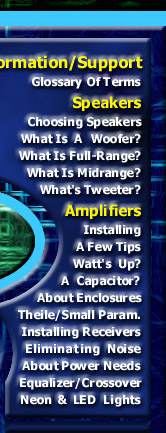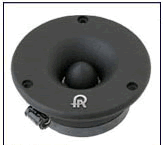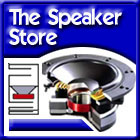




Technical
Help
& Education
Glossary Of Terms
Speakers Main Page
How Speakers Work
Choosing Speakers
What's A Woofer?
What's A Midrange?
What's A Tweeter?
Other Speaker Types
More Speaker Types
What's A Capacitor?
Installing A Capacitor
What's A Crossover?
What's An Equalizer?
Speaker Enclosures
Theile/Small Param.
About Power Amps
Installing An Amp
Installation Tips
Power Ratings
Installing/Replacing
Head Units/Receivers
Installing Neon/LED
Eliminating Noise
Use The Right Tools
Manufacturer's
Links
Personal
& Marine
Electronics
Laptop Computers
Cell Phones & PDAs
Portable TV & Video
Electronic Readers
MP3/Music Players
CD
Players/Booms
Earphones/Buds
Digital Cameras
Video
Cameras
Personal GPS
Bluetooth
Calculators
Accessories
Marine
Electronics
Stereo Amplifiers
Stereo Speakers
Stereo Woofers
Enclosed Speakers
TVS & Video
CD/Mp3 Receivers
GPS & Navigation
Fish Finders
Accessories
Home
Stereo &
Office Electronics
Flat
Screen & HD TVs
Surround Sound
Home Theater
DVD Players/Tivo
DVD Recorders
Blu-Ray Devices
Amplifiers/Tuners
Speaker
Systems
Subwoofer Drivers
Midrange
Drivers
Tweeter Drivers
Powered Subwoofers
Outdoor
Speakers
Stereo Accessories
Digital
Photo Frames
Video Game Systems
Game
Accessories
Video Games
Home Security/Alarms
Computer
Products
Desktops & Laptops
Add-Ons/Peripherals
Computer Monitors
Computer Software
Computer Games
Printers &
Scanners
Ink/Specialty Papers
Parts & Components
Computer Supplies
Security/Tech
Support
Auto
Electronics
Amplifiers
Subwoofers
Full-Range Speakers
Midrange Speakers
Tweeters
Power Capacitors
Empty
Enclosures
Loaded Enclosures
CD/Mp3 Receivers
CD Changers
Bass Packages
Car
TV & Video
Satellite
Radio
Bluetooth Wireless
GPS Navigation
Neon/LED Lighting
Radar Detectors
Chrome
Mufflers
Car Alarms/Security
V
AUTO
PARTS STORE
Auto
Wiring &
Accessories
Air Horns
Power
Antennas
Antenna Boosters
A/V Controllers
Bass Blockers
Crossovers
Dynamat
Equalizers
Fans (Cooling)
FM Modulators
Interfaces
Line Converters
Noise Filters
Power Inverters
Power Supplies
RCA Cables
RCA Splitters
Remote Controls
Signal Boosters
Vibration Control
Speaker Grills
Wiring Kits
Tweeters

Highs are reproduced by the tweeter, a small driver separate in many systems, but mounted in front of woofer cones in multidriver 2 and 3 way car speakers. Tweeters provide the sizzle and sibilance that give a more lifelike sense of presence to the experience of music. They come in three common types: Cones, Domes, and horns. Tweeters usually do not require very much power to create relatively loud sound. High frequency wavelengths are quite small and only a few watts can generate piercing levels of sound. Compare the tweeter whose radiating surface seems almost rigid, to a typical woofer where the cone may move up to 2 inches.
Cone tweeters are efficient and the most economical. They have a limited dispersion pattern.
Dome tweeters - the type found in most home speakers - have a more linear response and are more accurate. They also have a much wider dispersion pattern than any other type. Some domes are made of metals like neodymium or titanium that yield extended high frequency response. Others are made of Mylar, or a fine cloth like silk for a less extended but somewhat more linear, smoother sound. Some are made from a combination of materials.
Horn Tweeters are powered either by a dynamic (magnet & coil) diaphragm, or by a Piezo driver. They are the most powerful high frequency emitter but more directional, and may lack the extended range of the domes.
A typical car system might consist of a woofer in a box in the rear, midranges at the side and tweeters mounted on or in the dash panel. Here are some more detailed descriptions of the various types and aspects of tweeters.
Diaphragm
This term describes the sound-producing element in a tweeter or
horn
and is the surface that produces the sound you actually hear. The motor
that drives it can be any of several technologies including Piezo, co
nventional
dynamic, or ribbon types. See below for a description of each type.
Diaphragms do not produce bass and low midrange frequencies well, so
they are not usually found in those applications.
Dispersion
The extent to which a sound emitter yields acoustic radiation over a
given area, dispersion is a particular concern in tweeters whose portion
of the audio spectrum has a much more directional character than woofers.
Many
horn tweeters, while very energetic, have
a more limited area of dispersion within which their effect can be fully
perceived. Generally, dome tweeters can be
heard over a much
wider area, all other factors being equal.

Dom
e
Tweeters
Tweeters are of several different types; cones, horns and domes being
the most popular. Dome types are heavily favored in many standard applications.
They are efficient, and have low
Distortion
and wide dispersion. There is a choice between hard and soft dome materials,
but all have relatively low mass and high power handling capabilities.
Hard
Dome Tweeter
A characteristic of some Dome tweeters in which the dome is made of
some light, hard metal such as neodymium, and titanium as well as some
of the more rigid plastic compounds. The differences in reproduction
between hard ad soft dome tweeters are present, but very subtle. The
essential difference is in the higher frequencies that are often reproduced
by hard domes, up to 25kHz or more. Since many people tend to have acoustic
sensitivity that is sharply reduced or rolls off at 12 to 15 kHz, this
may not be an advantage.
Silk
Dome Tweeter
Dome tweeters in which the dome is composed of a treated soft silk like
material. This is a design that is much less susceptible to mechanical
deformation, and yet yields a fairly smooth response over the extent
of its range.
Piezo
Tweeter
A tweeter whose motor is simply a crystal of Piezo material through
which the signal current flows. The crystal lattice responds to this
by bending in proportion to the Amplitude and frequency of the incoming
signal. Piezo tweeters are very efficient drivers and are relatively
inexpensive. They come in a large variety of designs and radiators.
As a high impedance device, no crossover is needed in most cases.
Horn
Tweeter
A driver consisting of a relatively small emitter at the apex of a curvilinear
or exponential horn. This is an effective system for radiating high
frequencies in a variety of situations. The size and shape of the horn
will usually dictate the pattern and use of the driver. Long horns with
narrow apertures, tend to have the narrowest radiation pattern, and
are very useful in large listening rooms, especially where highly directional
effects, such as surround sound requires, are desired. Shallower versions,
with wider radiation patterns, have more general applications, especially
in car stereo applications where a wider field of coverage is desired,
along with a robust driver that can withstand severe environments. In
such situations, a Piezo driven emitter (driver) is highly desirable
for its ability to handle high-energy inputs on a variable basis.
Bullet
Horn Tweeter
A type of Dome tweeter in which the radiator has a large passive, bullet-shaped
device above its center that extends the nominal dispersion angle of
the sound so that it covers a greater area with a relatively small driver.
The illustration in the center of this page is an example.
Super
Tweeter
A driver constructed to reproduce the highest possible frequencies from
roughly 10 kHz to well beyond the usual threshold of audibility, 25
kHz and up. While most standard Tweeters can do an excellent job right
up to 16 or 20 kHz, these units deliver the most extreme parts of the
upper range for those fortunate (or not) few, who can actually hear
them.
MAIN
PAGE
GLOSSARY
SPEAKERS:
Choosing
General
Woofers
Miidrange
Tweeters
Full-Range
Full-Range 2
CAPACITORS
CROSSOVERS
EQUALIZERS
Theile/Small
AMPLIFIERS:
About
Installing
Install Tips
Power Ratings
RECEIVERS:
Installing
NEON/LED:
Installing
TOOLS
Home
--
Policies
--
Products
--
Tech
Center
--
Auto
Electronics
--
Home
Electronics
--
Personal
& Marine Electronics
--
Stereo
Tech Info
Website Designed & Maintained by
MetroDirect
Communications
Copyright (c) 2000 - 2009
Electronixwarehouse.com
.
Use of any material appearing on this site without specific written
permission is prohibitied by law.
electronixwarehouse.com
---
logobannerfactory.com
---
bleepthem.com (Political Satire)
---
rlebeaux.com
---
stereotechnicalinformation.com (Stereo
Technical Help)
---
electronixwarehouse.net
---
thespeakerstore.com
---
wmpublishing.com (Help For Writers)
---
barbarathenovel.com
---
cutethenovel.com




